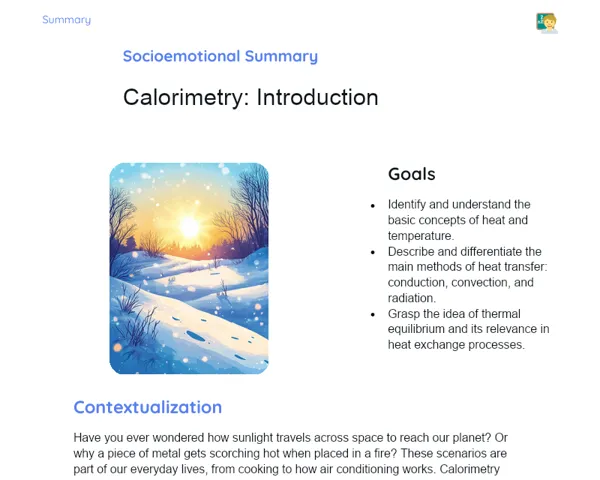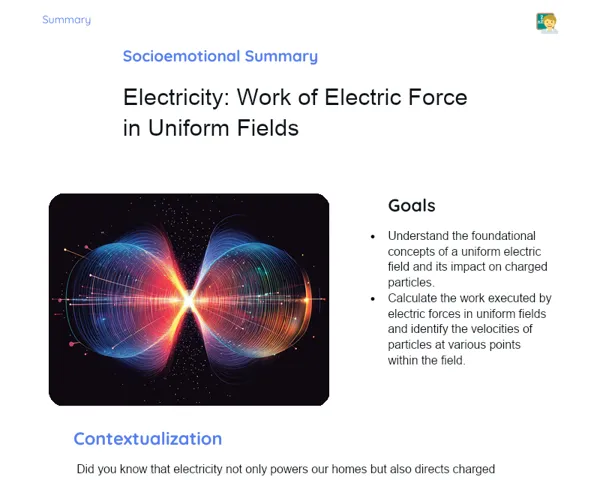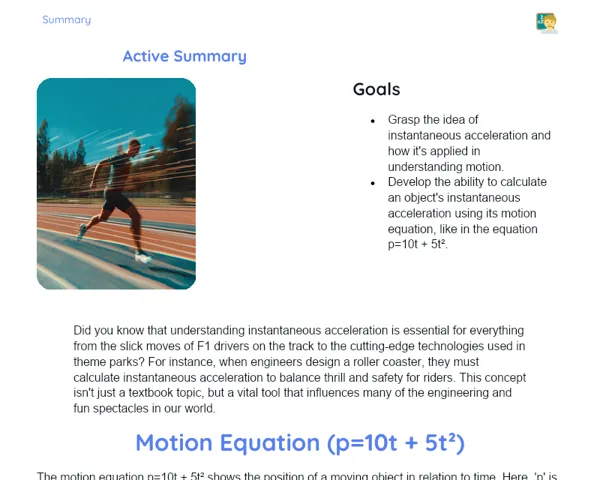Socioemotional Summary Conclusion
Goals
1. Identify the key graphs of uniform linear motion.
2. Utilise uniform motion graphs to solve related problems.
Contextualization
Have you ever noticed how cars maintain a steady speed on the roads? Or how trains travel smoothly without stopping? 🤔 These are practical examples of uniform linear motion! By grasping the graphs related to this type of movement, we can make safer and more efficient choices, such as calculating travel times or determining the appropriate speed for driving. Join us as we explore how these ideas play a role in our everyday lives and lay a sturdy foundation for our understanding of Physics and beyond! 🚗🏎️📈
Exercising Your Knowledge
Definition of Uniform Motion
Uniform linear motion (ULM) occurs when an object moves in a straight line at a constant speed. This indicates that the distance travelled by the object corresponds directly to the time elapsed. In ULM, there is no acceleration, making the motion predictable and consistent.
-
Distance Proportional to Time: In ULM, the distance increases linearly with time, simplifying predictions and calculations.
-
Constant Speed: The object's speed remains unchanged over time, allowing us to better understand and predict motion with less fuss.
-
Absence of Acceleration: In contrast to other kinds of motion, ULM has zero acceleration, which makes analysing the graphs and equations involved much simpler.
Time Equation of ULM
The time equation of ULM is S = S0 + vt, where S represents the position of the object, S0 is the initial position, v stands for the constant speed, and t is the time. This equation is vital for describing uniform motion and helps us in predicting the object's position at any moment.
-
Initial Position (S0): This indicates where the object started moving. Knowing S0 is critical to mapping the entire path of the object.
-
Speed (v): The constant speed specifies how much distance the object covers per unit of time and is essential for solving ULM problems.
-
Time (t): The elapsed time is crucial for calculating where the object will be at any moment and for understanding its movement over time.
Graphs of ULM
Graphs are helpful visual tools for understanding and analysing uniform motion. There are two primary graphs: the position vs. time graph (S x t) and the speed vs. time graph (v x t). Each of these provides valuable insights into the behaviour of the moving object.
-
Position vs. Time Graph (S x t): Here, position is plotted on the y-axis and time on the x-axis. The slope of the line indicates the speed of the object.
-
Speed vs. Time Graph (v x t): This graph shows the constant speed as a horizontal line. The area under this line reflects the total distance travelled.
-
Graph Interpretation: Understanding how to read these graphs is crucial for solving practical issues and grasping the dynamics of uniform motion.
Key Terms
-
Uniform Linear Motion (ULM): Movement in a straight line at constant speed.
-
Time Equation: S = S0 + vt, where S is the position, S0 is the initial position, v is the constant speed, and t is time.
-
S x t Graph: A graph showing position as a function of time, where the slope signifies speed.
-
v x t Graph: A graph displaying speed as a function of time, where constant speed appears as a horizontal line.
For Reflection
-
How can understanding the graphs of uniform motion help you make safer choices when driving?
-
In what ways can creatively visualising uniform motion enhance your focus and concentration in other aspects of life?
-
Recall a time when you were frustrated trying to grasp a new concept. How can you apply the emotional regulation skills we've discussed today to overcome that frustration?
Important Conclusions
-
Uniform linear motion (ULM) is a fundamental concept in Physics, describing how an object travels in a straight line at a constant speed.
-
The time equation of ULM, S = S0 + vt, is essential for predicting an object's position at any given time, making it a potent tool for tackling practical issues.
-
Graphs of ULM, such as the position vs. time graph (S x t) and the speed vs. time graph (v x t), are important visual representations for understanding and analysing object motion.
Impacts on Society
Grasping uniform linear motion is much more than an academic pursuit; it has tangible ramifications in our everyday lives. For example, when driving straight at a constant speed, you apply ULM concepts directly. This can assist you in planning your travel times better, saving on fuel, and even enhancing road safety since you’ll be able to calculate distances and times with more accuracy. 🚨🚗 Moreover, mastering these concepts can pave the way for career opportunities in fields like engineering, applied physics, and automotive technology. Being skilled at analysing uniform motion graphs also sharpens your analytical and problem-solving abilities – both of which are in great demand in today's job market. By honing these skills, you not only prepare yourself better for exams and academic assessments but also become a more informed and engaged citizen within your community. 🤵♂️🔬🚀
Dealing with Emotions
Let’s use the RULER method to manage our feelings while studying uniform motion graphs. First, recognise how you're feeling when approaching a new topic: are you anxious, intrigued, or maybe frustrated? Then, understand why you might feel that way. Perhaps the complexity of the graph confuses you, or you’re feeling pressed for time to grasp the content. Name that feeling: is it anxiety, frustration, or excitement? Next, express your emorions in a constructive manner, perhaps by sharing your challenges with a classmate or teacher. Lastly, regulate your emotions by engaging in relaxing activities, like the creative visualisation we did in class. This will help you tackle challenges with greater calmness and clarity. 🧘♂️📚
Study Tips
-
Create mind maps to connect the concepts of ULM, time equation, and graphs for better memorisation and understanding.
-
Practice solving everyday situations using uniform motion graphs. For instance, calculate the average speed of your daily commute to school.
-
Form study groups to discuss and tackle ULM exercises. Sharing ideas can clarify misunderstandings and solidify your grasp of the material.



